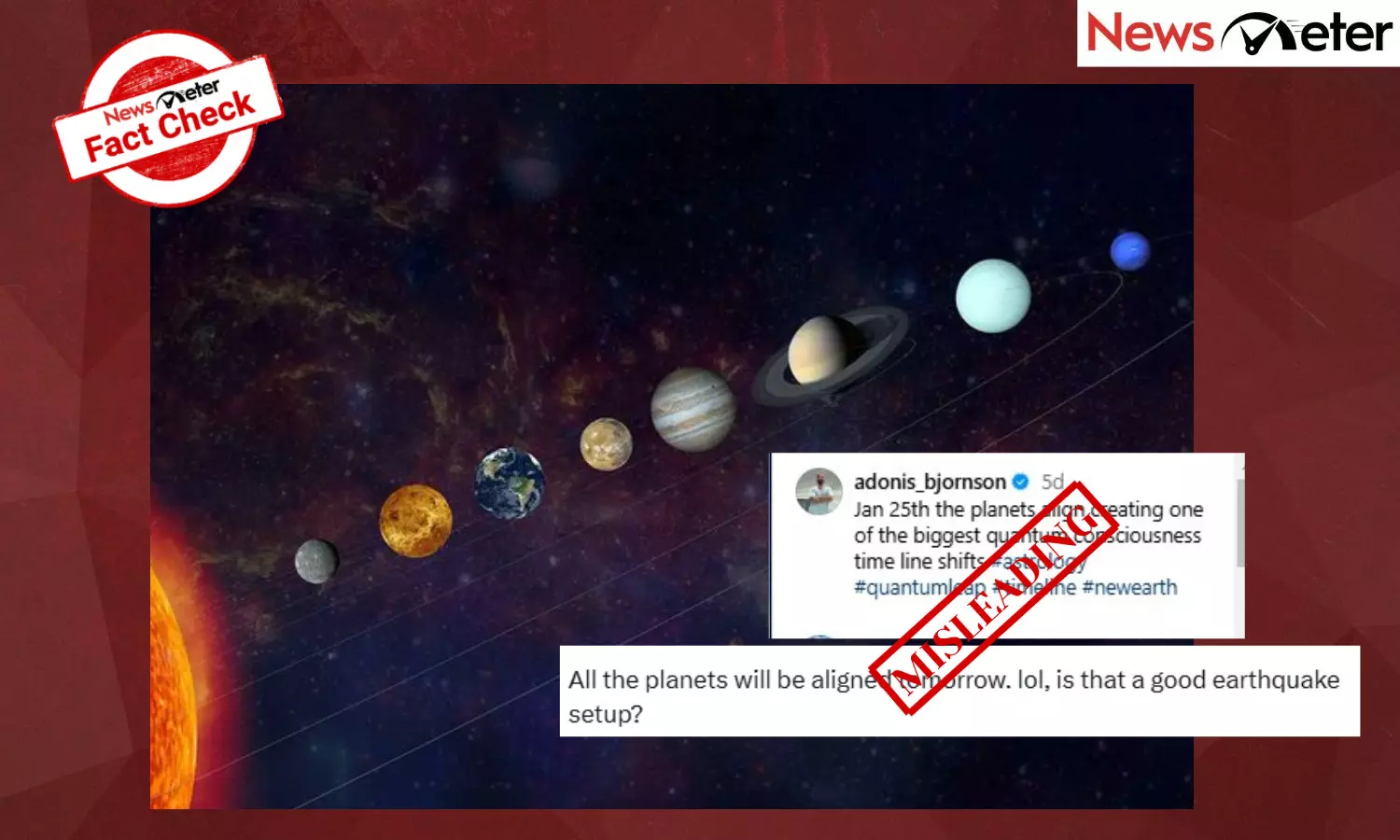Fact Check: Planetary Alignment on January 25 a rare celestial event? Know the truth
Claims of a "great planetary alignment" visible on January 25, 2025, are circulating on social media.
By Newsmeter Network
Claim:All eight planets will align perfectly on one side of the Sun and be visible in the night sky on January 25, 2025.
Fact:The claim is misleading. NASA clarified that six planets will be visible in the night sky throughout the January. However, the alignment is not particularly unique. Moreover, all eight planets will not be visible at the same time.
Hyderabad: Social media is abuzz with viral posts claiming a "great planetary alignment" on January 25, 2025. These posts assert that all eight planets will align perfectly on one side of the Sun and be visible in the night sky.
An Instagram user shared a video with the caption: “January 25th, the planets align, creating one of the biggest quantum consciousness timeline shifts. #astrology #quantumleap #timeline #newearth.”
The posts describe the event as a significant astrological and cosmic phenomenon, even claiming it will trigger a massive "timeline shift."
Fact Check
NewsMeter found that the claim is misleading. NASA clarified that six planets will be visible in the night sky throughout the month. However, the alignment is not particularly unique.
We conducted a keyword search and came across an article published by NASA on December 30, 2024, titled “What’s Up: January 2025 Skywatching Tips,” In the report, NASA emphasised that such planetary alignments, while intriguing, are not extraordinary events.
The report explains that four planets—Venus, Saturn, Jupiter, and Mars—will be visible in the night sky throughout January. Shortly after sunset, Venus and Saturn can be observed in the southwest, Jupiter will appear high overhead, and Mars will rise in the east. While Uranus and Neptune are also present, they require a telescope for clear visibility.
The report further clarifies that planets always appear along the same line in the sky due to their orbits, and this alignment is not particularly unique. What is more unusual in January is the opportunity to see four or five bright planets at once—a sight that does not occur every year. As for the term “planet parade,” NASA clarified it’s not a scientific phrase.
We also found a Forbes report by Jamie Carter, an award-winning journalist and experienced stargazer who writes about the night sky, astro-tourism, the northern lights, and space exploration. The article, titled “Debunked: January 25’s ‘Once In 396 Billion Years’ Planetary Alignment,” was published on January 17, 2025.
This report also noted that in January, six planets—Mars, Jupiter, Venus, Saturn, Uranus, and Neptune—are present in the night sky. However, it clarified that Uranus and Neptune will not be visible to the naked eye. By early March, Mercury will join the planetary lineup, briefly visible during the first week of the month.
Clarifying the claim of alignment, the report explained planets are always aligned with each other. The planets orbit the Sun in nearly circular paths, each one farther out and taking longer to complete its orbit. This flat, disk-like arrangement is called the plane of the solar system, similar to layers in an omelette. The article calls out the term “planet parade,” stating that it is often used by amateurs to describe instances when more than a couple of planets are visible in the night sky.
The report also debunks the claim that it is a “once in 396 billion years” event explaining misunderstanding arising out of a theoretical point made by Jean Meeus in his 1997 book, Mathematical Astronomy Morsels.
Condé Nast Traveller in a report published on January 24, quoted NASA’s public engagement specialist Preston Dyches as saying Planets always appear along a line in the sky, so the “alignment” isn’t special,” Dyches notes. “What’s less common is seeing four or five bright planets at once, which doesn’t happen every year.”
NewsMeter reached out to N. Raghunandan, Director of the Planetary Society India, who shared a detailed report he authored titled "Debunking the Viral ‘6 Planets Alignment Parade’ News/Videos/Campaign." In the report, Raghunandan clarified that the term "Planetary Parade" lacks scientific validity and is predominantly used in astrological contexts. He also highlighted that similar terms, such as asta graha kutami (8-planet alignment) and pancha graha kutami (5-planet alignment), have been popularised by astrologers and viral content.
Hence the viral claim of a perfect "great planetary alignment" on January 25, 2025, is misleading. While January offers an excellent chance to observe four planets with the naked eye and two with binoculars in the night sky, the alignment is neither rare nor as extraordinary as social media posts suggest. The exaggerated claims about quantum consciousness and timeline shifts have no scientific basis.